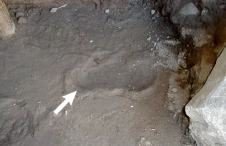Bow Stave Trees
Approximately 1,500 years ago, a new technology swept across Nevada. The bow and arrow allowed Native Americans to kill animals from farther away with more precision than they could previously achieve with weapons such as the atlatl and spear. These improvements may have resulted in more successful hunts that yielded greater supplies of meat for Native families, especially from large game such as deer, pronghorn, and bighorn sheep.
As the name implies, the bow and arrow is made up of two main parts: the arrow, with its arrowhead, shaft, and fletching (which allows the arrow to fly straight); and the bow, with its long wooden shaft (stave), a string and sometimes some backing material to strengthen, such as sinew or raw hide. Archaeologists find considerable evidence of arrows, especially in the arrowheads (projectile points) made of stone, bone, and occasionally wood. These are often seen across the landscape in many settings. Archaeological evidence of the bow is much rarer, as its main material (wood, sinew) does not preserve well except in a few dry caves. One unique archaeological expression of a bow is in the bow stave trees that still show the removal of staves—single pieces of wood. In Nevada, the known locations of bow stave trees can be counted on the fingers of one hand.
Accounts by Native people and experimentation reveal a great deal about how arrows are manufactured, but less information is available about making bows. Bow staves are typically made from wood, or wood combined with another material such as bone or horn. In Nevada, most bows were made of wood except those made by the Southern Paiute who used the highly-prized mountain sheep horns. Juniper was the common bow stave wood, but other wood may have been used as long as the trees were straight and with few knots.
Different Native American groups used bows of varying shapes and lengths, but construction of bow staves using juniper wood was similar. After finding a tall straight tree with an area free of branches, Native Americans would cut a notch at the lower end of the trunk and strip bark from the area above the notch. This notch stops the growth above it, allowing the stave to cure. Curing can take up to a year to complete. Allowing the stave to cure on the tree ensures that the bow stave is straight. After the stave is cured, a removal notch is made above the growth-arresting notch. How far up the notch is made depends on the desired length of the bow stave. In Nevada, lengths can range from forty to sixty inches. This notch is asymmetrical and used to pry the stave from the tree. The removed stave can then be worked into the final form. Typically, the unfinished stave is one-and-one-half to two inches wide and roughly the same thickness.
In the distant past notches were made with large tools made of broken cobbles or bifacial (worked on both sides) tools. Both are sometimes found close to the bow stave trees. In later times, metal axes replaced these chopping implements. The type of scarring present in the notches can distinguish the type of tool used. Stone tools tend to compress the wood grain as it is cut, whereas metal tools cut cleaner, damaging the grain less.
The number of recorded bow stave trees in Nevada and eastern California is small when compared with those found at other archaeological sites. Several factors can account for this. Fire has destroyed bow stave trees and they may have been used as either fuel or in mining structures during Nevada’s mining booms. Similarly, these trees may be cut down and used to build fences or as firewood.
Bow stave trees are also a unique resource that is not easily recognized in the field. Locations presently known include the White Mountains—with forty-seven in one stand of juniper—where they were also associated with wing traps used for hunting pronghorn and deer. The trees also appear in the Pine Nut Mountains in Nye County, the Wassuk Range in Mineral County, the Antelope Range in White Pine County, and near Mammoth, California. A bow stave tree may be seen on display at the Mono Lake Visitors Center near Lee Vining, California.
Article Locations
Related Articles
Further Reading
None at this time.

